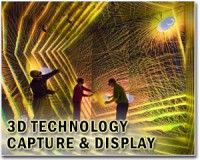 |
Corvallis, Ore. (UPI) Jan 28, 2011 Stereo vision" will let researchers study waves pounding against the shore to better understand a violent, ever-changing environment, U.S. scientists say. Engineers at Oregon State University say the system, using two video cameras feeding images to an advanced computer system, will allow researchers to observe large areas of ocean waves to see what they are doing and why, a university release said Friday. The system could be of great value as climate change and rising sea levels pose additional challenges to vulnerable shorelines threatened by coastal erosion around the world, researchers say. "An ocean wave crashing on shore is actually the end of a long story that usually begins thousands of miles away, formed by wind and storms," David Hill, OSU professor of coastal and ocean engineering, says. "We're trying to achieve with cameras and a computer what human eyes and the brain do automatically -- see the way that near-shore waves grow, change direction and collapse as they move over a seafloor that changes depth constantly." Applications could range from analyzing wave impacts to locating shoreline structures, building ocean structures, assisting the shipping industry, improving boating safety and reducing property damage, researchers say. Advances in computer science have made it possible to see what a dynamic marine environment is doing at the moment it happens, Hill says. "A wave is actually a pretty difficult thing for a computer to see and understand," Hill says. "Some things like speed are fairly easy to measure, but subtle changes in height, shape and motion as the waves interact with a changing ocean bottom, wind and sediments are much more difficult." Researchers have described the new system in the journal Coastal Engineering.
Share This Article With Planet Earth
Related Links Space Technology News - Applications and Research
 Computer makes 3D images from flat photos
Computer makes 3D images from flat photosBoca Raton, Fla. (UPI) Jan 19, 2011 A three-dimensional image of human faces can be constructed from flat 2-D images, a discovery that can be useful in security applications, U.S. researchers say. Researchers at Florida Atlantic University say biometrics, the technology of performing personal identification or authentication using an individual's physical attributes, is becoming an increasingly viable solution for identit ... read more |
|
| The content herein, unless otherwise known to be public domain, are Copyright 1995-2010 - SpaceDaily. AFP and UPI Wire Stories are copyright Agence France-Presse and United Press International. ESA Portal Reports are copyright European Space Agency. All NASA sourced material is public domain. Additional copyrights may apply in whole or part to other bona fide parties. Advertising does not imply endorsement,agreement or approval of any opinions, statements or information provided by SpaceDaily on any Web page published or hosted by SpaceDaily. Privacy Statement |